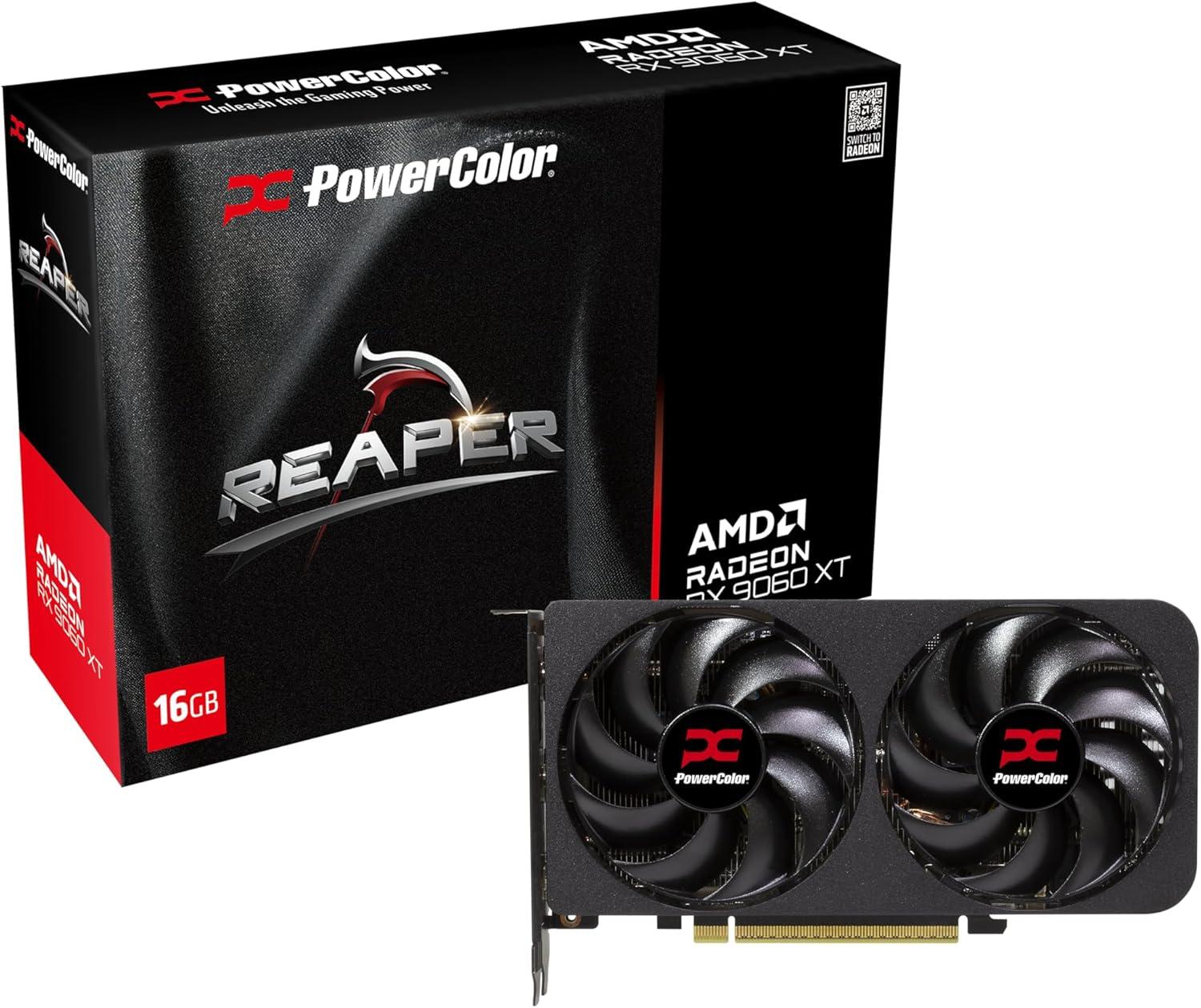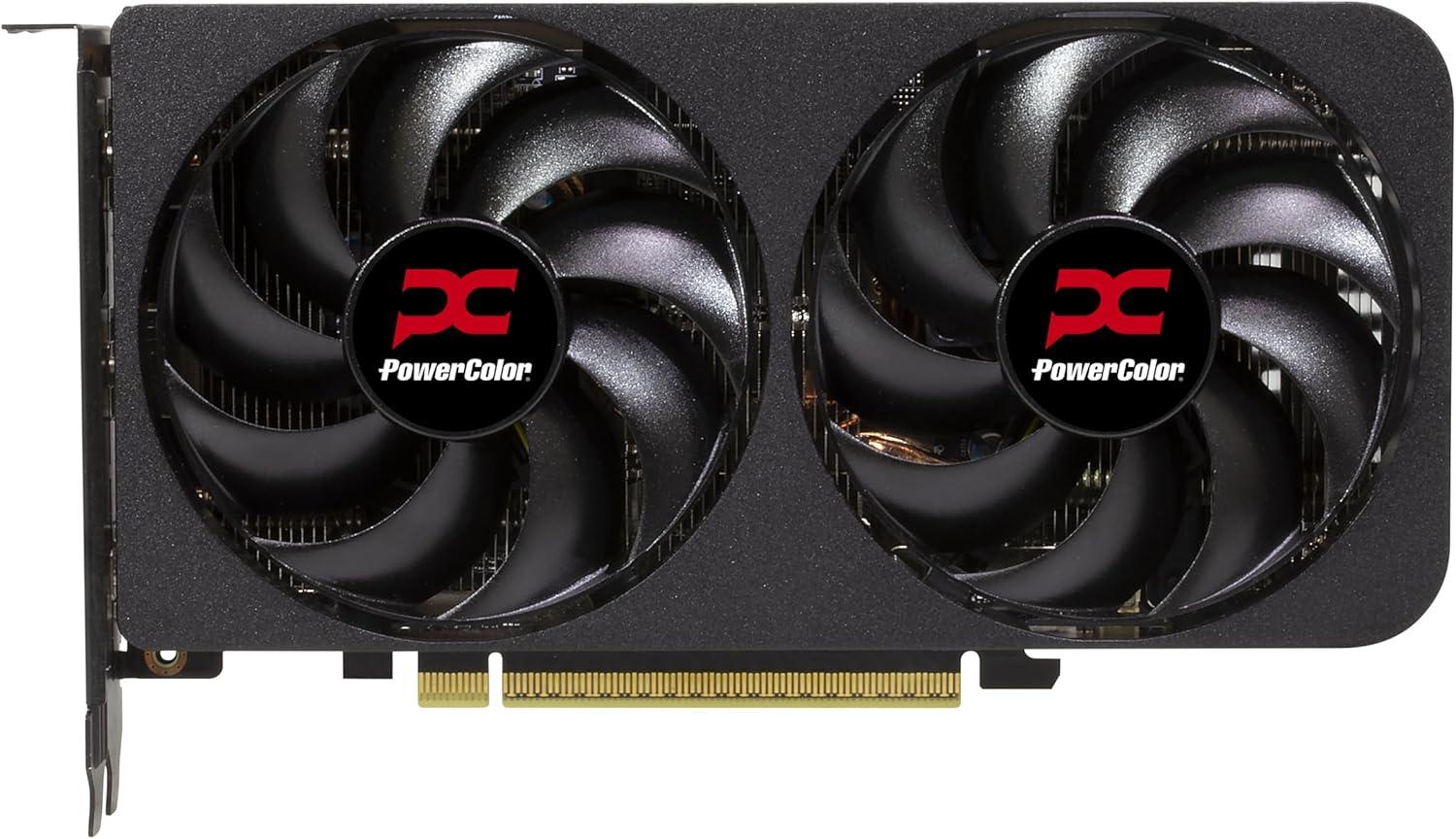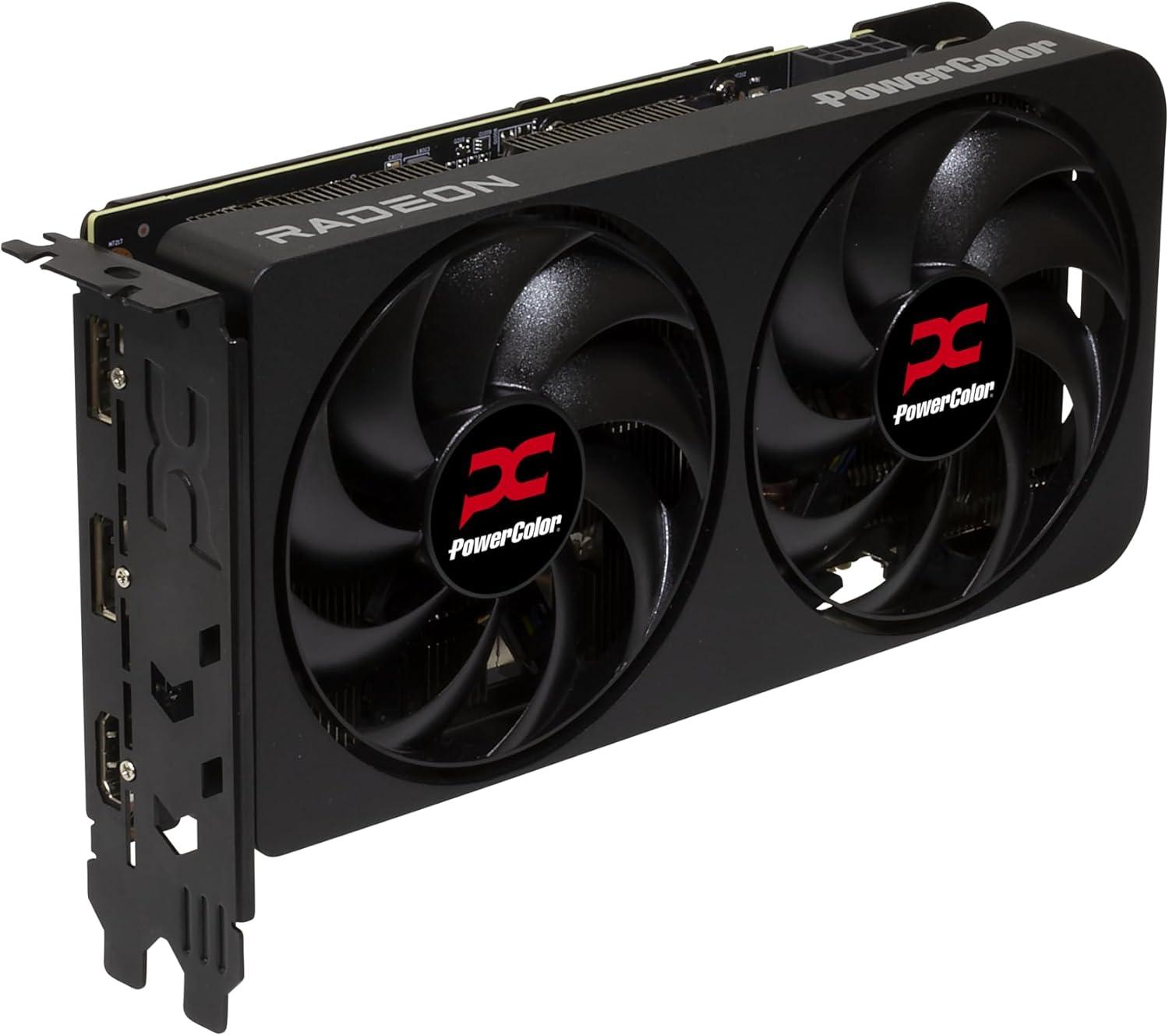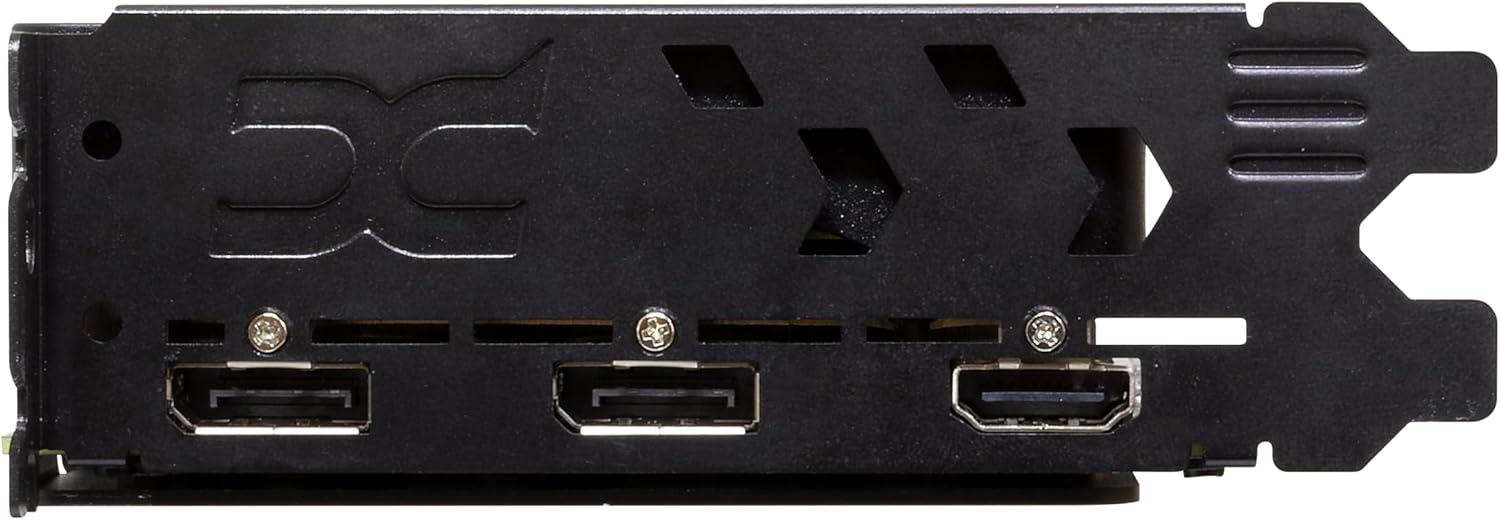PowerColor Reaper AMD Radeon RX 9060 XT 16GB
RX 9060 XT 8GB Review & Specifications
The RX 9060 XT 8GB is based on the RDNA 4.0 architecture and manufactured using the 4 nm process node. It was launched approximately 3 weeks, 6 days ago, originally priced at $299. It features 2048 cores, including 32 compute units (SMs), 128 texture mapping units (TMUs), and 64 render output units (ROPs). For ray tracing and AI-accelerated tasks, it also includes 32 dedicated RT cores and None Tensor cores, enabling advanced rendering and upscaling features where supported. It has a base clock of 1700 MHz and a boost clock reaching up to 3130 MHz. The RX 9060 XT 8GB comes equipped with 8 GB of GDDR6 memory across a 128-bit bus. Memory runs at 2518 MHz and delivers a total memory bandwidth of 322 GB/s.
This GPU has a low thermal design power (TDP) of 150 W. It is generally compatible with almost all PC cases and is excellent for SFF and compact systems where heat dissipation is a concern.
RX 9060 XT 8GB Performance
RX 9060 XT 8GB is a mid-range graphics card, scoring 40.92% in relative gaming performance. However, the limited 8 GB of VRAM may lead to severe memory bottlenecks at 4K, even with DLSS or FSR. It’s best suited for high FPS in 1080p or smooth 1440p performance, but not recommended for demanding 4K gaming.
The RX 9060 XT 8GB pairs a relatively powerful GPU core with a moderate VRAM size of 8 GB — a configuration that's becoming increasingly common. However, this pairing has sparked significant discussion in the gaming and tech review communities. Many modern GPUs with strong processing capabilities are equipped with insufficient VRAM (often less than 16 GB), which prevents them from realizing their full potential. As a result, GPUs like this one often deliver excellent performance in 1080p gaming at ultra settings, and perform well at 1440p in many titles. However, as modern games demand more VRAM — particularly due to high-resolution textures, ray tracing, and expansive open worlds — this limited memory becomes a bottleneck. In 4K gaming, performance can drop significantly due to VRAM exhaustion, leading to underutilization of the GPU core itself. Technologies such as DLSS or FSR can mitigate some of the performance loss at higher resolutions, but this often comes with a tradeoff in visual fidelity. This GPU configuration still handles basic to intermediate content creation tasks well — such as 1080p/1440p video editing, lightweight 3D modeling, and digital art workflows. For AI and machine learning applications, the GPU is capable of running small to mid-sized models and performing inference tasks. However, limited VRAM restricts its ability to handle larger models, which may require downsampling, reduced batch sizes, or precision reduction to run effectively.
PowerColor Reaper AMD Radeon RX 9060 XT 16GB achieves a solid performance-per-price ratio of 59.0%. It is suitable for current 1080p and 1440p gaming. However, due to the limited VRAM, it may struggle with future games or long-term use.
GPU Information
GPU Name: RX 9060 XT 8GB
GPU Code Name: Navi 44
Release Price: $299
Launch Date: 3 weeks, 6 days ago.
Architecture / Process: RDNA 4.0 / 4 nm
Cores / CUs (SMs) : 2048 / 32
TMUs / ROPs: 128 / 64
RT Cores / Tensor Cores: 32 / None
Base / Boost Clock: 1700 MHz / 3130 MHz
Memory: 8 GB GDDR6, 128 bit
Memory Clock / Bandwidth: 2518 MHz / 322 GB/s
Transistors: 29700 million
TDP: 150 W
Graphics Card Information
Name: PowerColor Reaper AMD Radeon RX 9060 XT 16GB
Manufacturer: PowerColor
Graphics Card Available: True
Current Price Amazon: $495
Amazon Price Updated: 6 hours, 2 minutes ago.
Factory GPU Clock: 3230 MHz
Memory Clock: 20 Gbps effective
Dimensions: 220mm*120mm*40mm
Power Connector: 8 pin x 1
Display Output: 1 x HDMI 2.1b,2 x DisplayPort 2.1a
Performance
Pixel Rate: 200.30 GPixel/s
Texture Rate: 400.60 GTexel/s
FP16: 51.28 TFLOPS
FP32: 25.64 TFLOPS
FP64: 801.30 GFLOPS
Gaming Performance
1080p: 40.92%
1440p: 33.17%
2160p: 25.51%
Calculated Performance
Performance per Price: 59.0%
RX 9060 XT 8GB Compared to Similar Performance GPUs
GPU Price / Performance Table
| GPU (Desc) | Price (Desc) | Gaming_1080p (Desc) | Gaming_1440p (Desc) | Gaming_2160p (Desc) | Game_1440p/Price (Desc) |
|---|---|---|---|---|---|
|
$409
|
0.0%
|
44.6%
|
36.6%
|
25.7%
|
78.7%
|
|
|
$419
|
↑
10.6%
|
42.8%
|
36.0%
|
29.9%
|
75.6%
|
|
|
$490
|
↓
-1.8%
|
42.5%
|
35.7%
|
30.6%
|
64.2%
|
|
|
$399
|
0.0%
|
40.3%
|
33.8%
|
28.5%
|
74.5%
|
|
|
$299
|
0.0%
|
40.9%
|
33.2%
|
25.5%
|
97.6%
|
|
|
$599
|
0.0%
|
38.8%
|
32.8%
|
28.7%
|
48.2%
|
|
|
$399❗
|
0.0%
|
38.5%
|
31.7%
|
25.7%
|
69.9%
|
|
|
$541
|
0.0%
|
39.1%
|
31.7%
|
24.3%
|
51.6%
|
|
|
$299
|
0.0%
|
38.8%
|
31.0%
|
24.0%
|
91.2%
|
GPU Specification Table
| GPU (Desc) | Architecture | Shader/TMU/ROP/RT | Base/Boost Clock | Memory | Mem Clock/Bandwidth | TDP |
|---|---|---|---|---|---|---|
| RTX 5060 Ti 8GB | GB206 / 4 nm / Blackwell 2.0 | 4608 / 144 / 48 / 36 | 2407 MHz / 2572 MHz | 8 GB GDDR7 / 128 bit | 1750 MHz / 448 GB/s | 180 W |
| RX 9060 XT 16GB | Navi 44 / 4 nm / RDNA 4.0 | 2048 / 128 / 64 / 32 | 1700 MHz / 3130 MHz | 16 GB GDDR6 / 128 bit | 2518 MHz / 322 GB/s | 160 W |
| RTX 3070 Ti | GA104 / 8 nm / Ampere | 6144 / 192 / 96 / 48 | 1575 MHz / 1770 MHz | 8 GB GDDR6X / 256 bit | 1188 MHz / 608 GB/s | 290 W |
| RTX 3070 | GA104 / 8 nm / Ampere | 5888 / 184 / 96 / 46 | 1500 MHz / 1725 MHz | 8 GB GDDR6 / 256 bit | 1750 MHz / 448 GB/s | 220 W |
| RX 9060 XT 8GB | Navi 44 / 4 nm / RDNA 4.0 | 2048 / 128 / 64 / 32 | 1700 MHz / 3130 MHz | 8 GB GDDR6 / 128 bit | 2518 MHz / 322 GB/s | 150 W |
| RTX 2080 Ti | TU102 / 12 nm / Turing | 4352 / 272 / 88 / 68 | 1350 MHz / 1545 MHz | 11 GB GDDR6 / 352 bit | 1750 MHz / 616 GB/s | 250 W |
| RX 6750 XT | Navi 22 / 7 nm / RDNA 2.0 | 2560 / 160 / 64 / 40 | 2150 MHz / 2600 MHz | 12 GB GDDR6 / 192 bit | 2250 MHz / 432 GB/s | 250 W |
| RTX 4060 Ti | AD106 / 5 nm / Ada Lovelace | 4352 / 136 / 48 / 34 | 2310 MHz / 2535 MHz | 8 GB GDDR6 / 128 bit | 2250 MHz / 288 GB/s | 160 W |
| RTX 5060 | GB206 / 4 nm / Blackwell 2.0 | 3840 / 120 / 48 / 30 | 2280 MHz / 2497 MHz | 8 GB GDDR7 / 128 bit | 1750 MHz / 448 GB/s | 145 W |
GPU Table Explanations
GPU (Asc): This refers to the name of the graphics processing unit (GPU).
Price (Asc): This column shows the price of the GPU, sorted in ascending order. The value next to the price indicates the percentage change in price compared to a previous day.
Architecture: This refers to the core architecture of the GPU, including the process node (nm), the underlying architecture name, and any notable features. For example, AD102 / 5 nm / Ada Lovelace tells us that the RTX 4090 uses the AD102 core, built on a 5 nm process node, and based on the Ada Lovelace architecture.
Shader/TMU/ROP/RT: These are performance metrics of the GPU:
- Shader: The number of cores responsible for handling calculations.
- TMU (Texture Mapping Unit): The number of cores involved in texture processing.
- ROP (Raster Operations Pipeline): The number of cores used in the final stages of the rendering process.
- RT (Ray Tracing Cores): The cores dedicated to ray tracing (advanced rendering effects).
Base/Boost Clock: These values indicate the speeds at which the GPU operates:
- Base Clock: The minimum speed at which the GPU runs.
- Boost Clock: The maximum speed the GPU can achieve under load.
Memory: This describes the amount of video memory (VRAM) on the GPU and its type. For example, 24 GB GDDR6X / 384 bit means the RTX 4090 has 24 GB of GDDR6X memory with a 384-bit memory interface.
Mem Clock/Bandwidth: The memory clock refers to the speed of the memory, while bandwidth indicates the amount of data that can be transferred per second. For example, 1313 MHz / 1010 GB/s means the memory clock speed is 1313 MHz and the memory bandwidth is 1010 GB/s.
TDP (Thermal Design Power): This is the maximum amount of power the GPU is expected to consume under full load, measured in watts. It also indicates the cooling solution needed. For example, 450 W means the RTX 4090 has a TDP of 450 watts.



